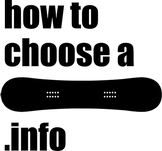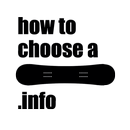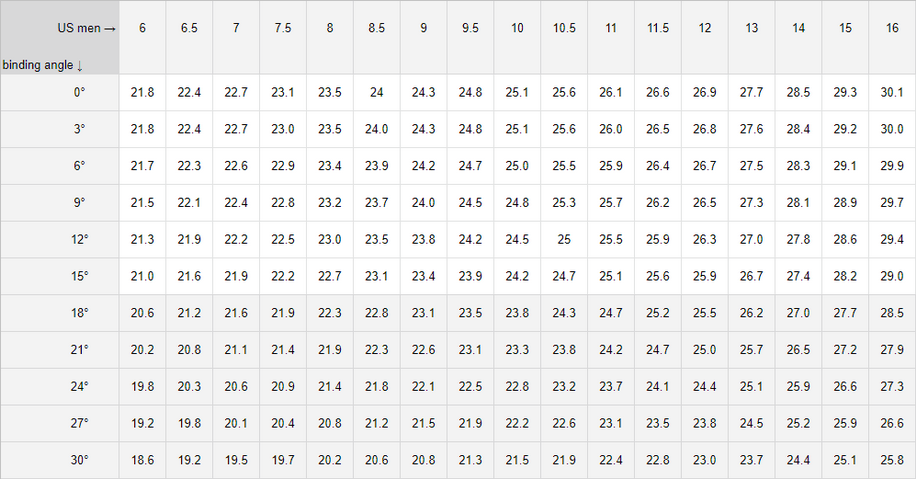Snowboard WIDTH (waist width)
The width has a major influence in how a board will turn and feel and is often overlooked. In a big way because there was a lack of good, complete information and a lot of over-extensive, inaccurate and confusing information on amateur snowboard blogs. But have no fear, now you're here! We've made a width chart that takes you from your feet size to your minimum waist width in a flash. You'll finally know the minimum waist width for your feet size and fell ready to buy a snowboard with confidence. Quick and easy! Do you have a ruler (or know your feet/boot size) and a few free minutes? If so, let's go.
How to choose the width of your next snowboard
Any board width will work fine as long as it's not too narrow for your boots/bindings size and back binding angle. The minimum width for you depends on your feet size and back binding angle and the best width for you depends on what you want to do with the snowboard. Knowing the minimum width for your boot size and back binding angle, you can look for snowboards with that width or wider depending on your preference or riding style, and that's it. Seriously!
Beginners and intermediate snowboarders, just get a board with a width that matches your bindings/boots size. Check the board's specs for a recommended binding size. If there is no recommendation, find your boot size in the snowboard width chart bellow (go with 9 for the back binding angle) to see what's the minimum waist width for you boot size, then check out the waist width measure of the boards you consider (on the boards specs.) to make sure they are not narrower.
Curious intermediates and advanced snowboarders, look for wider or narrower boards, depending on riding style, just make sure they are not to narrow for your boots/bindings size and back binding angle. Know the minimum waist width for your boot size and back binding angle on the width chart bellow and the waist width of the snowboards you are considering to buy on their specs (on the board itself or at the boards brand/manufacturer website).
Snowboard width chart for boot size + back binding angle + riding style
This snowboard width chart will let you know the minimum waist width for you according to your feet/boot size and back binding angle, in centimeters (cm), and then adjust it to your riding style. Based on math and physics. Quick and easy!
2 look for the minimum snowboard waist width for your boot size and back binding angle on the chart bellow
3 adjust accordingly: park 0 | beginner 0 | All mountain +2mm | pipe +3mm | carve/race +5mm
Maximum waist width for beginners We suggest the one correspondent to your boot size with the back binding at 0 (zero) degrees. Or just stay within the range in white, from 0 to 15 degrees, for your boot size. Remember, a narrower snowboard is easier to control at first.
Maximum waist width for intermediate and advanced snowboardes We suggest until 1,5cm (15mm) wider than the minimum waist width for your boot size and back binding angle. Think twice before buying a snowboard any wider than that without trying it first. This is if you can find one, production snowboards tend to stay within that range, more on the wider end or more on the narrower end but within the range.
note: If you want a snowboard in a size (length) but that snowboard in that size has a smaller waist width than the minimum waist width suggested in the chart for your boot size and back binding angle, you can look for a wide version of that snowboard size (look for sizes with a W after the length, like 154W). Maybe you'll need to round the chosen size because there are not wide versions for every snowboard size.
Snowboard width for riding style / Width influence in board performance

Standard width snowboard = toes and heels over edges to press them effectively and get total control over the snowboard.
Because any snowboard boots will have very close to 2cm more than the feet inside them, your toes and heels will be over the toe edge and heel edge if your boots overhang the edges by about 1 to 1,5 cm on each side, when mounted on the bindings.
Wider snowboard = boots overhanging the toe and heel edges by closer to or by less than 1cm on each side, usually until 0,5cm underhang.
Better edge engagement; easier to keep on edge; more stability; less prone to toe/heel drag; more floaty; more prone to catch edges.
Great to carve properly, to ride powder and to any rider who favors stability.
Think you want a wider snowboard? Look for snowboard sizes with a W (like 159W) those are "wide snowboards", they're wider than usual for their size (length). Want to go wider than the available production "wide snowboards" allow you to? Get yourself a custom made snowboard or check out the Donek kanpton twin, the only production snowboard that's wider than the norm, it's actually wider than other brands "wide snowboards"!
Narrower snowboard = boots overhanging the toe and hell edges by closer to or by slightly more than 1,5cm on each side.
Quicker edge changes; easier to initiate turns; more playful; less prone to catch edges; more prone to toe/heel drag.
Great to play around the slopes and park, to beginners, and to any snowboarder who favors playfulness.
Waist width vs Width at inserts

Waist width The width measures presented by snowboard brands in the boards specs. are the tip width, the tail width (the maximum width of the snowboard at each end) and the waist width (minimum width of the snowboard - image bellow). The waist width is the measure typically used to choose a snowboard width or to refer to it. The waist width from production snowboards for adults ranges from 235mm to 270mm and on snowboards for the younger ones (sizes from about 80 to about 140) the waist width range is 170mm to 245mm. Within the same snowboard size the waist width wont vary more than 9mm and it does vary less than that for most snowboard sizes.

Width at inserts It would be easier to choose a snowboard width without physically trying it by matching boots with boards if every board's specs. included the "width at inserts" measure. The width at inserts is what really matters when finding the standard snowboard width for your boot/feet size and binding angles, but the math to get to the width at inserts from the waist width, side cut, stance width, binding angles and boot size measures is undoable for most of us. But good news, that's not a problem for literally anyone! Because the difference that may exist between the width at inserts of various snowboards that have the same waist width and a similar size (length) but different shapes and side-cuts is very very small (the reason for that is that most snowboards have very similar side-cuts) and will have no influence at all in how your boots/bindings fit on a snowboard or on how a snowboard will perform. Like 1 or 2cm are not a real problem when choosing a board size, 1 or 2mm are also not a problem at all when choosing a board width with accuracy. Remember, apart of not going narrower than your feet size and back binding angle allows you to, to avoid toe/heel drag, the snowboard width is a choice.
How to choose a snowboard with the width you want in various situations
At a shop with your boots with you
At a shop that does not have the board you want in the size you want
Do as said before with the same model on other size and check out the waist width measure (on the specs), then know the waist width of the size you want and compare them. If your boots stuck out, for example, 2cm on each side (too much) on a snowboard with a waist width of 240mm (24cm), then on a snowboard with a waist width of 250mm (25cm), they will stick out only 1,5cm each side (acceptable). Would you like that board model's size to be wider? Look for the closest size to the one you want that has a W on it (like 153W) that may have a waist width of about 260mm.
Put your boots over the inserts with approximately the angles you use, the boots shall not stick out more than 1,5cm each side (toes and heels) and shall not underhang more than 0,5cm.
At a shop without your boots with you but knowing their size
Grab a pair of boots on your size and do as said before.
At a shop without your boots with you and not knowing their size
1 Try some boots, get a pair that fits you and do as said before (you obviously don't need to buy the boots).
or 2 Put the snowboard you fancy on the floor and, barefooted, step on the inserts (maybe one foot at a time and without putting your weight on the snowboard) with your approximate stance and binding angles. Look for its waist width on the specs. and try some wider snowboards if that board was too narrow, or some narrower snowboards if it was too wide. If it was a good fit, or when you find one, you may want to consider some other boards with the same waist width or similar.
Do as said before with the same model on other size and check out the waist width measure (on the specs), then know the waist width of the size you want and compare them. If your boots stuck out, for example, 2cm on each side (too much) on a snowboard with a waist width of 240mm (24cm), then on a snowboard with a waist width of 250mm (25cm), they will stick out only 1,5cm each side (acceptable). Would you like that board model's size to be wider? Look for the closest size to the one you want that has a W on it (like 153W) that may have a waist width of about 260mm.
You are at home, or somewhere... , and want to buy online
Just read this page from the start or go straight back to the width chart. You just need to know your feet/boot size or to measure it. Hey, you're already here! More about snowboard width / Snowboard width F.A.Q.
The width of a snowboard (measured in millimeters at the narrowest part of the snowboard, called waist) usually ranges from 235mm to 265mm. For choosing purposes the "width at inserts" would help, but the brands don't include it in the boards measures so we use the waist width, specially to buy online.
All that influences how your boots will fit in your board
boot size; binding angles; stance width; stance setback; sidecut
Relation between size and width on a snowboard
Because higher people tend to have bigger feet, the width of a snowboard keeps up with it's length. For example, a snowboard model size 156 will be slightly wider than the same board model in size 152.
What is a "wide snowboard"?
A "wide snowboard", sized as 158W or 160W for example, with the W after the size on the board's specs, is a snowboard that's wider than usual for it's size (length). Like a 156 sized snowboard that usually has a waist width measure of 250mm, with a waist width measure of 260mm and sized as 156W.
Women's specific snowboards are typically narrower to go with the smaller size, but they may be even narrower to acomodate womens smaller feet (a 146 woman snowboard may be narrower than a 146 man snowboard). Like on men boards, there are wide versions (ex: 146W) available.
You'll find the same snowboard model in sizes like 154, 156, 156W, 158, 159W, 162, 162W.
Both, the size (ex: 157W) and the waist width measures (ex: 245mm), come with any board specifications sheet (physically or online).
Both, the size (ex: 157W) and the waist width measures (ex: 245mm), come with any board specifications sheet (physically or online).
Probably not. You will need it to avoid toe/heel drag if: 1- your feet/boots are bigger than usual for your height; 2- you'll mainly carve as hell or ride powder with that board you'll get.
Frequent mistake to avoid: It happens a lot for people to think "I have big feet" and to go for a wide board that they don't really need or want, because: 1- they're also tall and their normal board size already accommodates their feet. 2- they're beginners/intermediates who wont experience any toe/hell drag unless their toes/hells are way out of the board (like 5cm or more), and they may not notice it but the unnecessary extra width will make it harder to roll from one edge to the other in the first turns.
As a 154 board from one brand may have the same width as a 154W from other brand, to choose a snowboard width for our riding style we better focus on the actual width of the board (the width at inserts if shooping in loco or the waist width if buying online), instead of on the W sizing given by the brands.
Will I benefit from a wider or from a narrower board instead of one with a standard width for my feet/boot size?
If you want to carve hard on a normal snowboard with soft boots, ride powder, or if you're a bit overweight you may benefit from some extra width (boots ending 0,5cm before edges or 0,5cm after edges). Otherwise you may be happier with a thinner snowboard (boots out of the edges by 0,5cm to 1,5cm), the thinnest possible without causing toe/heel drag (boots sticking out the edges 1,5cm), specially if you're more of a park rat.
Why? How will more or less width than the standard width influence my riding?
Less width (with 0,5cm to 1,5cm of our toes/heels sticking out) means a easier turn initiation, a quicker edge change, a snappier feeling, a more playful ride, at the cost of risking some toe/heel drag in sharper turns. More width (the edges wider than toes/heels by 1,5cm max. each side) is welcome to ride powder (more floating capacity) and to carve hard jumping from arc to arc, or from arc to whatever! (no toe/heel drag at all, ever), and it may feel steadier at higher speeds and help you keep your line, at the cost of slower edge changes and more energy demanding turn initiations.
Should I worry about the side-cut?
Not at all! The width at inserts of 2 snowboards with the same size and waist width but diferent side-cuts won't vary more than 2mm. That is an aceptable tolerance for EVERYONE. The same goes to the stance position, to the stance width, to the bindings height and to the differences is width between the front and back inserts in tapered boards (narrower on the back than on the front).




